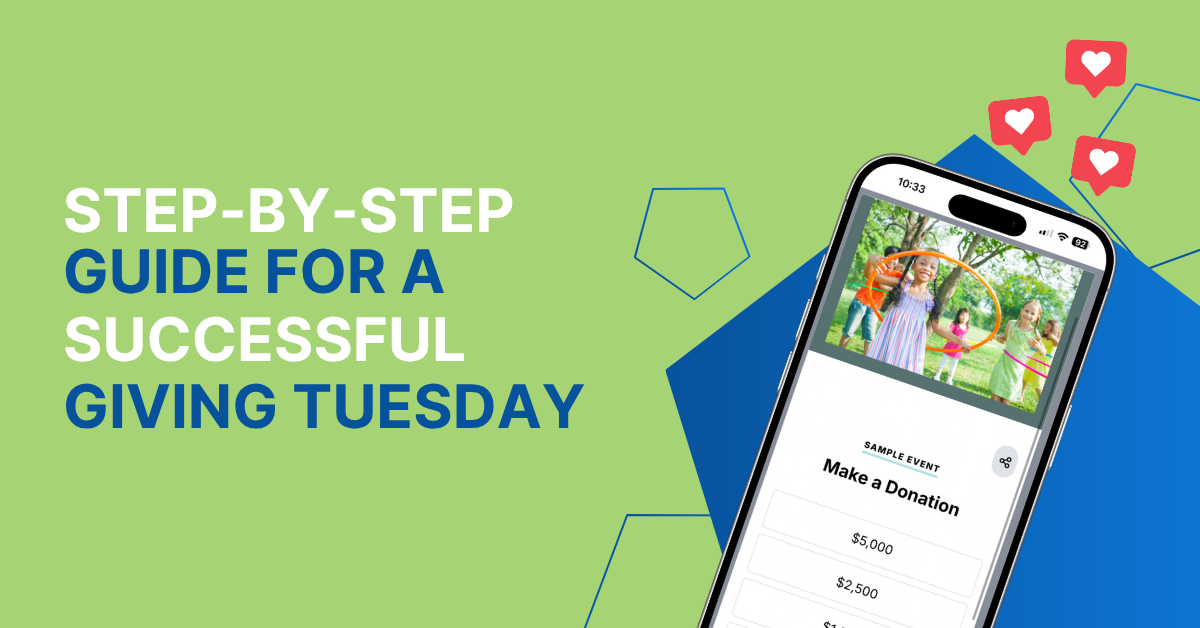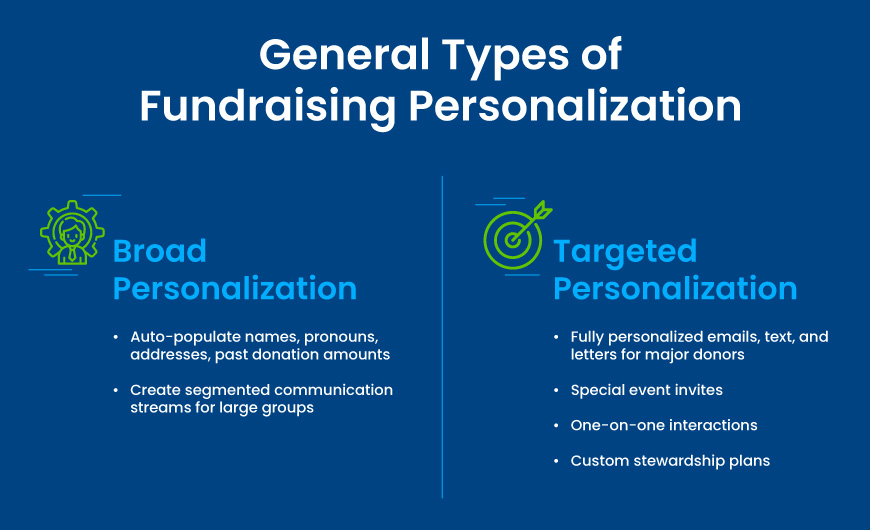
Unlock Fundraising Personalization at Scale with AI
January 4, 2024Artificial intelligence brings all kinds of new improvements for nonprofits. With the rush of development and change we’ve seen in just the past couple of years, integrating AI into your workflows is certainly an exciting prospect, and fundraising is the natural first place many organizations have looked to.
While AI can’t (and shouldn’t) completely handle all aspects of your fundraising, it can significantly streamline parts of your fundraising processes that require simple, time-intensive, repetitive tasks—just like outreach personalization.
Many nonprofits already understand the value of personalization and speaking to donors as individuals whenever possible, but it’s very challenging to accomplish at a large scale.
There’s simply not enough time to personally draft effective emails and year-end greetings to every active donor in your database, nor would this be a great use of your time anyway since not every donor generates the same level of value for your organization over time. That’s not to say every donor doesn’t deserve personal attention, though, so what do you do?
AI can help—by automating parts of the process, you can personalize your donor outreach more efficiently and personalize it for more donors than would otherwise be feasible. Let’s take a closer look at the context before diving into the specific roles that AI tech can play.
Why Fundraising Personalization Matters
Personalizing your communication to donors and the overall stewardship strategies you use to engage them generates powerful benefits for your nonprofit.
It boosts fundraising results by signaling greater relevance to donors. Along the way, it helps deepen your relationships with donors as they feel acknowledged as individuals and are presented with messages and asks tailored to their interests. One study found that 71% of donors feel more engaged by nonprofits when they receive personalized outreach and content.
If you can make effective personalization an ongoing practice for your organization and seek to continuously learn more about your donors, you can see a powerful flywheel effect take root—improved fundraising, engagement, and retention.
The Forms of Fundraising Personalization
More than half of nonprofit organizations already add some form of personalization to their messages. However, this is often done on a single communication channel—like email or text message campaigns—or to a single audience. This limited approach makes sense (personalization is time-intensive), but it leaves so much potential engagement on the table.
It’s important to understand all the forms that personalization can take in your strategies. When we think about outreach personalization, adding recipient names to emails to mind. This is a foundational strategy that works, but there’s more to effective personalization than this one step.
Personalization can be loosely broken down into general categories: broad and targeted.

- Broad fundraising personalization is done for relatively large audiences. It can be a great way to cover your bases and boost overall engagement, but it’s often not a top priority for nonprofits because it can be difficult to do efficiently. It includes tactics like:
- Auto-populating names, pronouns, locations, and past donation amounts into messages via integrations between your communication tools and database.
- Creating message series (usually email streams) for particular donor segments to generally tailor the content they receive. For example, you might send different streams to active donors, frequent volunteers, and supporters who lapsed within the past couple of years.
- Targeted fundraising personalization is done for very small segments or individuals who have outsized impacts on your nonprofit. Major donors are the most important group in this category. Although the time and resources needed for this level of personalization are high, so are the potential returns when these supporters give large gifts and stay engaged over time. Targeted personalization can look like:
- Fully personalized emails, texts, and letters written for individuals
- Curated event invitations based on the donor’s interests
- One-on-one phone calls and meetings to discuss your work and learn more about the donor
- Customized stewardship plans based on your organization’s priorities, the donor’s giving motivations, and capacity as revealed through prospect research
By understanding the different areas of your fundraising processes where personalization can help, you’ll be better able to find ways to incorporate new tools like AI. Maybe it can strengthen what you’re already doing or fill gaps in your strategy that you’ve never had the time to address before.
How AI Can Help
Artificial intelligence tools can support your personalization efforts on both the broad and targeted fronts by reducing the time and resources needed.
First, auto populating CRM data like names and addresses has long been possible, but AI takes it a step further.
The right tools can screen your database to generate and auto populate suggestions based on data-backed predictions, like suggested donation amounts. This takes all the guesswork out of accomplishing something that would otherwise be completely time-prohibitive, tailoring your asks down to the individual level and encouraging larger donations in the process.
Segmentation, the process of sorting your donors into discrete groups to better communicate with them or steward your relationships, is another foundational tactic strengthened by AI. By predicting likelihoods, you can quickly generate and refine your segmentation strategies to build smarter broad personalization into your outreach.
For example, tools built for this purpose, such as DonorSearch Ai, can predict which of your donors is likely to:
- Respond to a donation ask
- Give within the next year
- Give their first donation
- Create a recurring gift
- Give a donation over $250
- Give the most over the lifetime of your relationship
Use this information to easily create segmented lists that will support your current goals, and then draft messages that are highly tailored to them.
This is also an effective way to reach those donors who weren’t yet on your radar but are likely to make a gift based on their engagement and interest—for instance, if you discovered a large group of donors who are likely to give over $250, you could further research and qualify that list to expand your pool of prospects at various giving levels and guide your outreach going forward.
Looking specifically at major donors, AI insights and analyses can help you drastically improve how you prioritize your one-on-one outreach to them. By ensuring you’re putting the time into personally communicating with those who are the most likely to respond or give at any given time, you ultimately make your efforts more efficient and boost overall fundraising ROI.
Plus, AI can bring a whole range of ways to more generally tailor the donor experience. Web-based AI tools can tailor your blogrolls and newsletters to donors’ interests automatically, for instance, effortlessly sorting them into message streams for you. Not to mention, generative AI has become more effective than ever at drafting broad messages for email, social, and text message campaigns (just be sure to always double-check and refine their outputs to guarantee correctness and appropriateness).
Personalization is the key to enriching your donor relationships, driving engagement, higher fundraising results, and ultimately improved retention. AI is pushing the frontiers of what’s considered feasible, resource-effective personalization.
Consider how your organization is already personalizing its outreach and how you’re sorting and prioritizing donors for communication purposes. Are there gaps in your strategy? Tactics you’ve always wanted to try but never had the time? Then, consider how technology can help you fill those gaps.
The nonprofit AI space is quickly expanding with new platforms and tools every day, so it’s important to guide your search if you decide to invest in one soon. Understanding the ethics and tenets of responsible AI usage will be a valuable first step and will give your team a concrete set of guidelines to consider as you weigh your tech options and lay out an implementation plan.
Get The Latest Updates
Subscribe To Our Monthly Newsletter
No spam, notifications only about new products, updates.
Become a subscriber
Subscribe to our blog and get the latest updates straight to your inbox.

